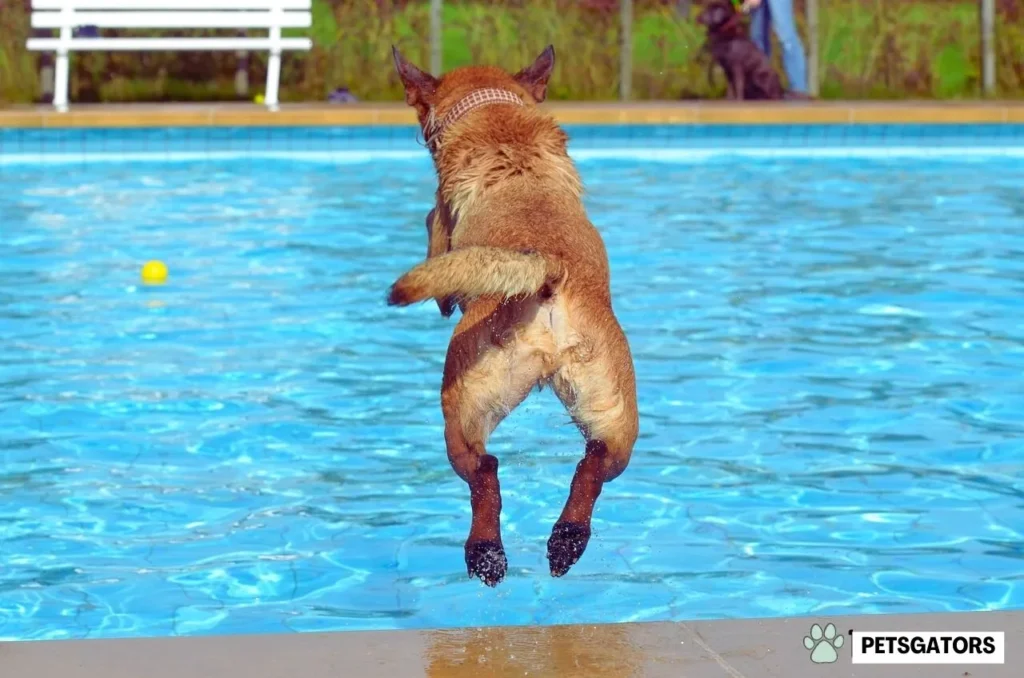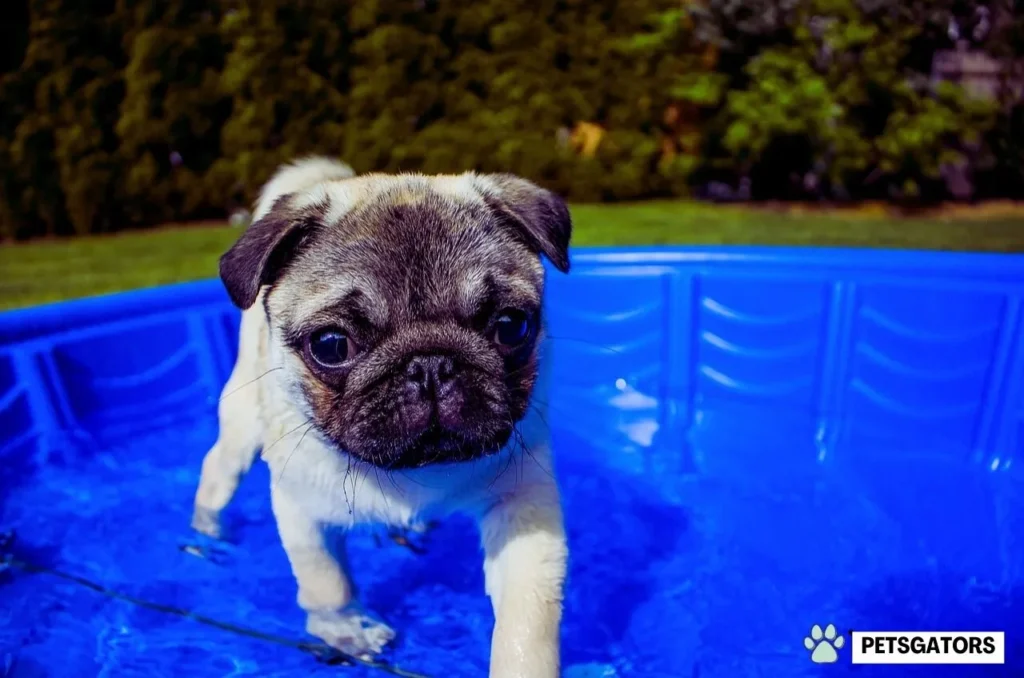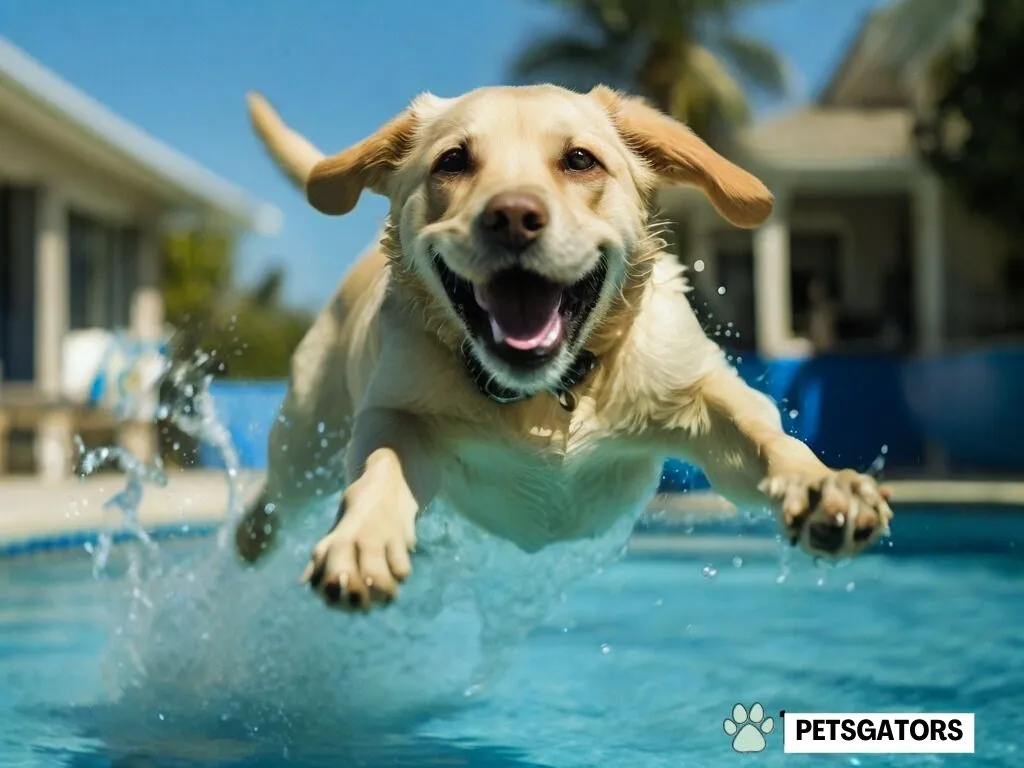Dog Pool Swimming
Hello, fellow dog lovers! Are you pondering the joys of swimming with your furry friend? You’re in the right place! Welcome to our ultimate guide to dog pool swimming, where we dive into everything you need to know about this fun and beneficial activity. Whether you’re a seasoned dog owner or new to the world of canine aquatics, this guide is packed with tips, tricks, and answers to your burning questions.
Table of Contents
How Long Should a Dog Swim in a Pool?
Let’s start with a common question: How long should your four-legged swimmer be in the pool? Like humans, dogs have different endurance levels, and swimming can be quite the workout! A good rule of thumb is to start with short sessions of about 10 minutes and gradually increase as your dog gets more comfortable and builds stamina. Always watch for signs of fatigue, and remember – safety first!

The Benefits of Having a Dog Pool
You might wonder, “Is it a smart decision to have a swimming pool specifically for dogs?” Absolutely! Dog pools are more than just a fun way to cool off on a hot day; they offer numerous health benefits. Swimming is a low-impact exercise that can improve cardiovascular health, muscle strength, and joint flexibility. This is particularly advantageous for senior canines or those suffering from joint inflammation. Plus, it’s a fantastic way to burn off that extra energy!
Creating the Perfect Dog Swimming Pool
So, how do you make a dog swimming pool? Whether you’re thinking of buying one or DIY-ing, there are some key factors to consider. Choose a pool with sturdy, dog-friendly materials and ensure it’s the right size for your pooch. If you’re leaning towards a homemade option, safety and accessibility should be your top priorities. Remember, not all dogs are natural swimmers, so consider adding a ramp or shallow steps for easy entry and exit.
Training Your Dog to Love the Pool
If your dog seems a bit hesitant about taking the plunge, don’t worry! Training your dog to like the pool requires patience and positive reinforcement. Start by encouraging them to step into shallow water and gradually increase the depth. Use toys and treats to make it a fun experience. Consistency is key, and soon enough, your dog might be the one begging you for a swim!
Safety Tips for Dog Pool Time
Safety is paramount when it comes to dog pool swimming. Always supervise your dog around water, even if they’re strong swimmers. Consider a life vest for extra safety, especially for breeds that aren’t natural swimmers. Keep the pool area free of hazards and ensure your dog knows where to get in and out of the pool.
The Importance of Post-Swim Care
After a great swimming session, it’s crucial to take proper post-swim care of your dog. Rinse off chlorine or any chemicals from their fur, check their ears for water to prevent infections, and give them a cozy towel dry. And, of course, some post-swim cuddles are always a good idea!

Understanding Your Dog’s Swimming Capabilities
Not all dogs are born swimmers – and that’s okay! Breeds like Labradors and Retrievers are natural swimmers, but others might need more encouragement and training. For an in-depth look at how different breeds take to the water, check out “How Can All Dogs Swim? A Guide To Canine Aquatics“
When to Avoid the Pool
It’s also important to know when pool time isn’t a good idea. If your dog is unwell, stressed, or recovering from an injury, it’s best to skip the swim. Always consult your vet if you’re unsure about your dog’s health and swimming.
Fun Pool Games and Activities
Make pool time even more exciting with fun games and activities! Fetch, water-based agility exercises, or even a simple game of chase can make swimming an enjoyable and rewarding experience for your dog.
The Definitive Manual:
Is It Advisable to Allow Your Canine Companion to Swim in Your Pool?
For more detailed information and expert tips on dog pool swimming, don’t forget to check out “The Ultimate Guide: Should You Let Your Dog in the Pool?” This resource is a treasure trove of information for any dog owner looking to make a splash with their pet
Choosing the Right Pool for Your Dog
Selecting the right pool is crucial for your dog’s swimming experience. If you have a small dog or a puppy, consider a shallow, inflatable pool. For larger dogs, a more durable, hard plastic pool might be better. Ensure the pool’s sides are low enough for your dog to get in and out easily but high enough to keep the water contained during those exuberant doggy paddles!
The Role of Exercise in Pool Time
Swimming is not just fun; it’s also an excellent form of exercise for dogs. It engages multiple muscle groups, improves endurance, and can be a godsend for dogs with high energy levels. It’s a fantastic way to exercise your dog, especially during the summer when it might be too hot for long walks.
Balancing Fun and Discipline
While pool time is fun, it’s also a great opportunity to reinforce training and discipline. Use this time to practice commands like ‘come’, ‘stay’, and ‘leave it’. This not only keeps your dog safe but also helps strengthen the bond between you two.
Dealing with Pool Anxiety in Dogs
Some dogs might be anxious about swimming. If your dog is nervous, never force them into the water. Instead, use positive reinforcement and gradually introduce them to the pool. You can start by simply playing near the pool and slowly encouraging them to step in when they’re ready.
The Best Dog Swimming Accessories
To enhance your dog’s pool experience, consider investing in some swimming accessories. Dog life jackets are essential for safety while floating toys can add an extra layer of fun. Also, consider a dog-friendly sunscreen for breeds with short fur or light-colored coats to protect them from sunburn.
Cleaning and Maintaining Your Dog’s Pool
Keeping the pool clean is essential for your dog’s health. Regularly change the water to prevent algae and bacteria growth. If you’re using a larger pool, consider a pool cover to keep it clean, and check the pH levels if you’re using chemicals.
Winter Swimming – Indoor Options
Don’t let the cold weather dampen your dog’s love for swimming! Indoor dog pools are a great option during the winter months. They offer controlled environments where your dog can swim safely year-round. Look for local doggy daycares or pet centers that offer indoor swimming facilities.

Recognizing and Responding to Emergencies
It’s important to recognize signs of distress in the water and know how to respond. Signs like excessive panting, whining, or struggling should be taken seriously. Always be prepared to assist your dog out of the pool and know basic pet first aid procedures.
Incorporating Swimming into Your Dog’s Routine
Gradually incorporate swimming into your dog’s routine for the best results. Start with once a week and see how your dog responds. If they enjoy it and it suits their health and fitness needs, you can increase the frequency.
Celebrating the Joy of Swimming with Your Dog
Lastly, remember to have fun! Swimming with your dog is not just about exercise or staying cool; it’s about enjoying the time you spend together. Capture these moments with photos, invite friends and their dogs over for pool parties, and make the most of these splashing good times.
Closing Thoughts:
Swimming can be a delightful and enriching activity for both you and your dog. By following the tips and advice in this guide, you can ensure a safe, fun, and healthy swimming experience. Remember, every dog is unique, so tailor your approach to their preferences and abilities. Happy swimming!
Conclusion:
There you have it, the ultimate guide to dog pool swimming! This enjoyable activity can provide countless hours of fun and health benefits for your furry friend. Remember to always prioritize safety, understand your dog’s unique needs, and most importantly, have fun! So, grab that doggie life jacket, and let’s make a splash!
FAQs about Dog Pool Swimming
Can all breeds of dogs swim naturally?
No, not all dog breeds are natural swimmers. Breeds like Retrievers and Spaniels usually take to water easily, but others, like Bulldogs and Pugs, may struggle due to their body structure. It’s important to introduce any dog to water gradually and never assume they can swim instinctively.
How often should I clean my dog’s pool?
It’s recommended to change the water in your dog’s pool every few days, or more frequently if it’s visibly dirty. If you’re using a larger pool with a filter system, maintain it as you would a regular pool, checking the chemical balance regularly to ensure it’s safe for your dog.
Is it safe for dogs to drink pool water?
It’s best to discourage dogs from drinking pool water, especially if it contains chlorine or other chemicals. Always provide fresh, clean drinking water nearby when your dog is swimming.
What should I do if my dog doesn’t like to swim?
Not all dogs enjoy swimming. If your dog is hesitant, never force them into the water as this can cause fear and anxiety. You can try gradually introducing them to water through play and positive reinforcement, but some dogs may always prefer to stay dry.
Are there specific swimming safety gear for dogs?
Yes, there are several safety gear options for dogs. The most important is a well-fitted dog life jacket, especially for breeds that aren’t natural swimmers or for dogs swimming in deep or open water. Other useful items include water-resistant dog boots for rocky areas and sun protection gear for dogs with light coats.







